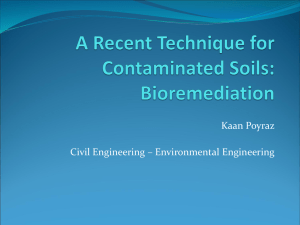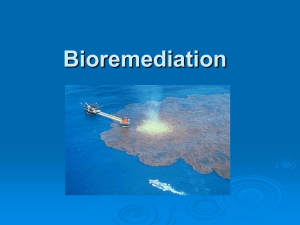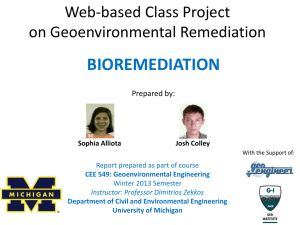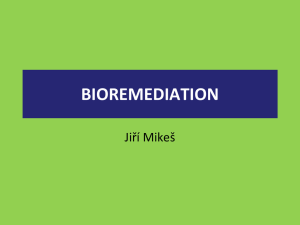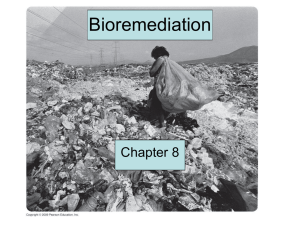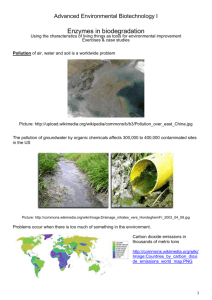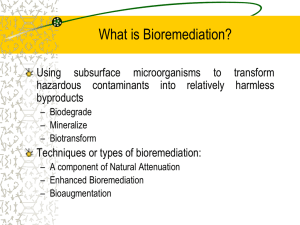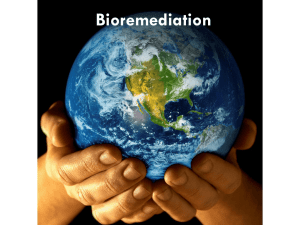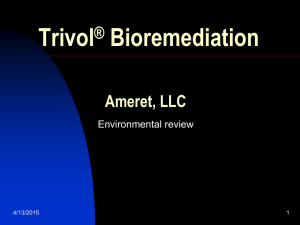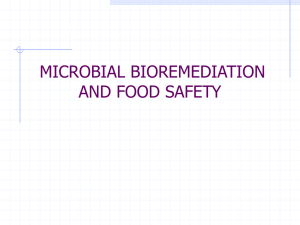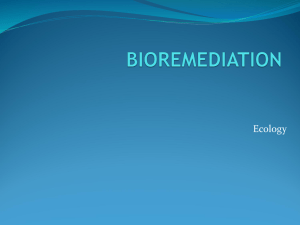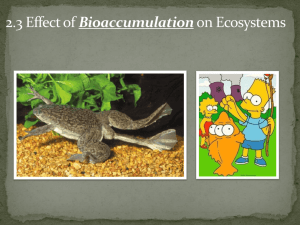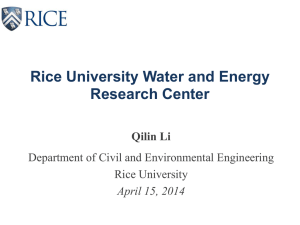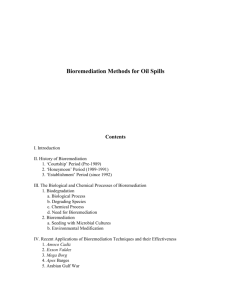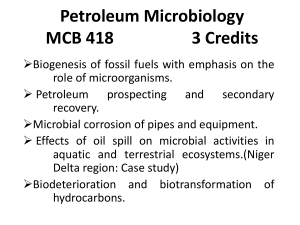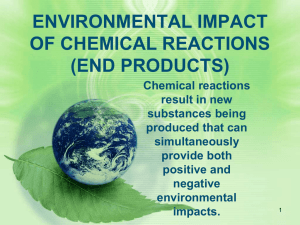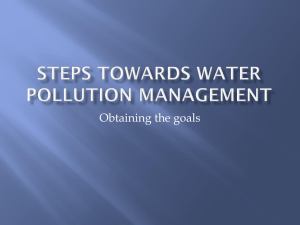An Integrated Earth
advertisement
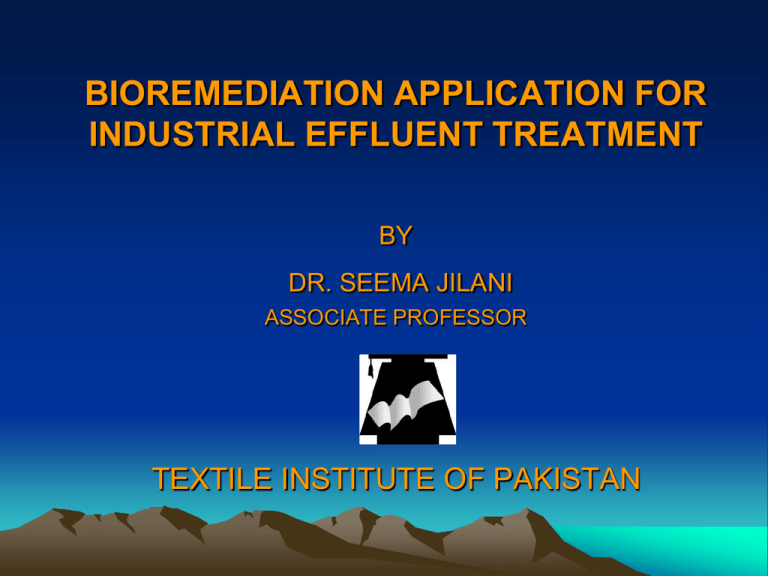
BIOREMEDIATION APPLICATION FOR INDUSTRIAL EFFLUENT TREATMENT BY DR. SEEMA JILANI ASSOCIATE PROFESSOR TEXTILE INSTITUTE OF PAKISTAN Contents Introduction Concern Study objectives & benefits Industrial Contaminants & their Impact Treatment Technologies Bioremediation Technology Bioremediation Principles & Mechanism Factors Influencing Bioremediation Advantages & Disadvantages of Bioremediation Conclusions Introduction Increased urbanization and industrialization has given rise to serious water pollution and environmental problems. Discharge of industrial effluent as well as chemical spills, domestic sewage, and pesticides use are the main cause of environmental pollution. Manufacturing & processing industries that have led to serious environmental contamination includes tanneries, fertilizers, textile, refineries, chemicals, vegetable oils, paper and pulp, sugar and food industries. Cont……. Introduction Karachi, a hub of industrial activity, houses seven major industrial estates in Korangi, Landhi, SITE, Federal B Area, North Karachi, Superhighway and Port Qasim. At present, Karachi coastal region has become a dumping ground of hazardous waste, receiving huge quantities of untreated domestic & industrial wastewater through Lyari & Malir Rivers. Since most industries have no treatment facility or have grossly inadequate arrangements. Cont……. . Introduction Accelerated rate of fresh water contamination in the city is divulging the problem of water scarcity. Continued practice will ultimately threatens fresh water availability and food security for future as well as health hazards and economic losses. With new regulations and a greater environmental concern, industrial effluent treatment need especial attention. Current Concern Contaminated water is responsible for over 12 million deaths per year world over. More than 40% hospital beds in Pakistan are occupied by patients with water related diseases. According to Economic Survey of Pakistan 2008-09, economic losses due to water pollution in the country are estimated at Rs.109.5 billion per year. While National Drinking Water Policy Document 2009 mentions the same at about Rs.112 billion per year, over Rs.300 million a day, in terms of health costs and lost earnings. Water Pollution in Karachi Karachi, population over 18 million discharged around 446 MGD of wastewater. About 70% untreated wastewater discharged into the Arabian sea. All most all chemical waste are dumped untreated into storm-drains, open nallahs or in the lyari and malir rivers which ultimately fall into the Arabian Sea. The coastal zone, extended up to 135 Km, is exposed to heavy pollution load of both domestic and industrial origin. Cont…… Water Pollution in Karachi In Karachi, over 120 million gallons of wastewater containing hazardous chemicals (produced by 4,000 industrial units, 2,000 legal and the same number of illegal industries) is being discharged into the sea without proper treatment. Preventing water pollution is critically important to ensure sustainability of the locale’s development. Aim & Objectives To provide an overview of bioremediation technique ---- an environmentally sound, economical and sustainable technique for industrial effluent treatment. To discuss the importance of microorganisms and the essential factors required for industrial effluent treatment. Overall aim is to provide scientific information about remediation of hazardous waste in soil and water environments. Benefits The information would be valuable to scientists who are trying to develop method for the treatment of toxic compounds. The study would be helpful in improving the design and operation of biomechanical treatment system used for degradation of toxic compounds. Further, the study may contribute to the improvement of public health, sanitation, soil integrity and the conservation of fresh water resources. Wastewater Contaminants suspended solids biodegradable organics pathogens Contaminants of concern in wastewater treatment nutrients priority pollutants (EPA designated toxics) refractory organics (organics that don’t biodegrade) heavy metals dissolved inorganics Contaminants Impact Toxicants such as detergents, fertilizers, metals, pesticides and many other chemicals lead to progressive deterioration of environmental quality. These chemical compounds may be toxic, mutagenic, carcinogenic and may be bioaccumulated or biomagnified by the biota. Hazardous compounds persists because environmental conditions are not appropriate for the microbial activity that results in biochemical degradation. Contaminants Impact Contaminants Impacts on the environment suspended solids lead to sludge deposition and anaerobic conditions biodegradable organics lead to oxygen depletion and odors problem pathogens transmission of communicable diseases nutrients (N,P) causes eutrophication, oxygen depletion and toxicity problem Cont………… Contaminants Impact Contaminants Impacts on the environment non-biodegradable Organics resist conventional treatment heavy metals Consequences for disposal and reuse of sludge & wastewater. dissolved inorganics agricultural crop production as well as protein production in aquaculture (fish/duckweed) might reduced. (e.g. detergents, phenols, pesticides). Treatment Importance Efficient and reliable method for industrial effluent treatment are needed to prevent water pollution to conserve essential natural resource to protect human health and ecosystem to comply with environmental protection regulations. Treatment Options Various conventional methods used for decontamination of toxic wastes are: Activated carbon adsorption Chemical oxidization Incineration Direct photolysis Biological degradation (Bioremediation) Bioremediation Technology Of all the technologies that have been investigated, bioremediation has been found to be the most cost effective and environmental friendly treatment option for many environmental pollutants. Bioremediation is a pollution control technology that uses biological systems to catalyze the degradation or transformation of various toxic chemicals to less harmful forms. Bioremediation Technology Bioreactors technologically are the most sophisticated category of environmental bioremediation. Bioreactors offer a much faster means of waste biodegradation than land treatment and more control over reaction conditions and effluent quality than simple biofilters. Major Players In bioremediation, microorganisms are used to destroy or immobilize waste materials. Microorganisms include: Bacteria (aerobic and anaerobic) Fungi Algae Actinomycetes (filamentous bacteria). Bioremediation Principle Bioremediation is based on the idea that organisms are capable to uptake things from the environment and use it as food to enhance their growth and metabolism. With this unique characteristic lay the fundamental principle of bioremediation, to use microorganism to take in contaminated substances from the environment or convert it to a nontoxic form. Bioremediation Process 1. Microbes releases enzyme to break down the contaminant into digestible pieces. 2. The contaminant of organic substances is ingest and digest as food along with other energy source by the cell. GOAL Degrade organic substances that are hazardous to living organisms and convert the organic contaminants into inert products. How does bioremediation work ? Chemicals present at contaminated sites become part of the metabolic process. For example, Hydrocarbon oxidizing organisms develop on oil films. Microbes attach to insoluble oil droplets and begin the process of decomposition. Various bacteria produce surfactants that aid in the biodegradation of fuels. The surfactant helps to decrease the surface tension and disperse the oil to allow maximum access to biodegrading microorganisms. How does bioremediation work? Some time toxic intermediates form during microbial transformations Biodegradation involves the breakdown of organic compounds either through biotransformation into less complex metabolites or through mineralization into inorganic minerals, H2O, CO2 or CH4. e.g. formation of vinylchloride during degradation of perchlorethylene. Heavy Metal Treatment The recovery of metals by microbes or microbial products is more advanced. Fungi produce several extracellular products which can complex or precipitate heavy metals. For example, many fungi and yeast release high affinity Fe-binding compounds that chelate iron. The Fe3+ chelates which are formed outside the cell wall are taken up into the cell. In Saccharomyces cerevisiae removal of metals is done by their precipitation as sulphides e.g. Cu2+ is precipitated as CuS. The best-known example of microbial metal metabolism is the mining microbe Thiobacillus ferrooxidans. This bacterium and other related species derive energy by utilizing metallic sulfides. Factors Influencing Bioremediation For bioremediation of harmful chemicals following factors are required to be monitored in the effluent: Required microorganism Temperature pH level Dissolved oxygen concentration Inorganic nutrient. These conditions allow microbes to grow and multiply—and eat more chemicals. When conditions are not right, microbes grow too slowly or die or they can create more harmful chemicals. Advantages of Bioremediation Ecologically sound, a natural process Target chemicals are detoxified Economical On-site elimination of waste Disadvantages of Bioremediation Research is needed Slow process Toxic by-products are produced Conclusions Bioremediation continues to be the favored approach for processing biological wastes. Bioremediation utilizes microbes such as bacteria, fungi, yeast, algae, and some plants. Three categories of bioremediation techniques have been identified: in situ land treatment (treatment of contaminated material on site), biofiltration, and bioreactors. Bioremediation is highly efficient system, if proper conditions are maintained example pH, temperature, DO, nutrients. Bioremediation is cost-efficient and helps chemical and physical methods of managing wastes and environmental pollutants. Good quality and quantity of freshwater is a key to sustainable socio-economic development
